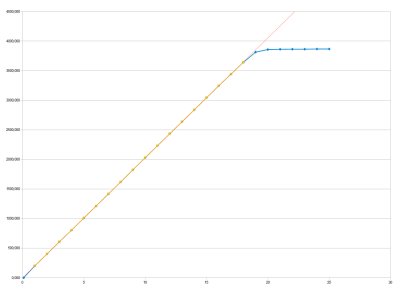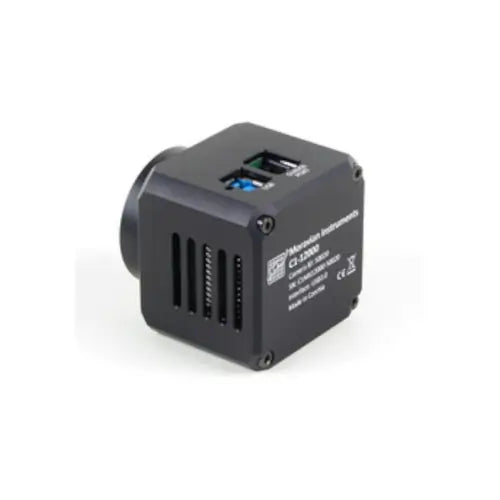Moravian Instruments C1-12000 CMOS camera with Sony IMX253 sensor
Global shutter CMOS 4112 × 3008 pixels, USB 3.0 interface
The C1 series cameras with global shutter CMOS sensors were designed to be small, lightweight imagers for Moon and planets and for automatic telescope guiding. With proper image calibration, C1 cameras provide surprisingly good results also in entry-level deep-sky imaging. The used CMOS sensors response to light is linear up to very close to saturation point, so, C1 cameras can be used for scientific applications like variable star research, too.
C1 camera models are equipped with Sony IMX global shutter CMOS detectors with 3.45 × 3.45 μm square pixels. Individual models differ in resolution only.
All used sensors utilize global electronic shutter. This means every pixel within the image is exposed in the same time, as opposed to rolling shutter sensors, which exposes individual lines one after another. There is no difference for long exposures of static objects, but imaging of moving objects using short exposure time using rolling shutter leads to image shape distortions.
Two lines of C1 cameras are available depending on the available dynamic range (bit-depth of the digitized pixels):
-
C1 cameras with Sony IMX sensors supporting 8- and 12-bit digitization. Because every 12-bit pixel occupies two bytes when transferred to host PC, 12-bit image download time is longer compared to 8-bit image. Maximal FPS in 8-bit mode is then significantly higher.
-
C1 cameras with Sony IMX sensors supporting 12-bit digitization only. As the 12-bit read mode is always used for long-exposure applications (astronomical photography, scientific research) either way, lower theoretical download time in 8-bit mode brings no limitations for real-world scenarios. All other parameters being same (sensor size, resolution, pixels size, noise, …), lower price of these cameras may be then very attractive.
C1 camera models with 8- and 12-bit digitization:
| Model |
CMOS sensor |
Resolution |
Pixel size |
Image area |
| C1-1500 |
IMX273 |
1456 × 1088 pixels |
3.45 × 3.45 μm |
5.02 × 3.75 mm |
| C1-3000 |
IMX252 |
2064 × 1544 pixels |
3.45 × 3.45 μm |
7.12 × 5.33 mm |
| C1-5000 |
IMX250 |
2464 × 2056 pixels |
3.45 × 3.45 μm |
8.50 × 7.09 mm |
| C1-12000 |
IMX253 |
4112 × 3008 pixels |
3.45 × 3.45 μm |
14.19 × 10.38 mm |
C1 camera models with 12-bit digitization only:
| Model |
CMOS sensor |
Resolution |
Pixel size |
Image area |
| C1-3000A |
IMX265 |
2064 × 1544 pixels |
3.45 × 3.45 μm |
7.12 × 5.33 mm |
| C1-5000A |
IMX264 |
2464 × 2056 pixels |
3.45 × 3.45 μm |
8.50 × 7.09 mm |
| C1-12000A |
IMX304 |
4112 × 3008 pixels |
3.45 × 3.45 μm |
14.19 × 10.38 mm |
Camera Electronics
CMOS camera electronics primary role, beside the sensor initialization and some auxiliary functions, is to transfer data from the CMOS detector to the host PC for storage and processing. So, as opposite to CCD cameras, CMOS camera design cannot influence number of important camera features, like the dynamic range (bit-depth of the digitized pixels).
Sensor linearity
The sensors used in C1 cameras shows very good linearity in response to light. This means the camera can be used also for entry-level research projects, like for instance photometry or brighter variable stars etc.

C1-3000 (IMX252) response to light
Download speed
As already noted, there are two lines of C1 camera series, differing in the used sensor. The first series offers four different read modes:
-
8-bit slow mode with ~132 MPx/s digitization speed
-
12-bit slow mode with ~72 MPx/s digitization speed
-
8-bit fast mode with ~263 MPx/s digitization speed
-
12-bit fast mode with ~132 MPx/s digitization speed
Remark:
The slow variant of both read modes can be used to slightly lower the amount of heat generated by the sensor, as the communication interface operates at half speed compared to fast mode. Also, when the camera is connected using USB 2.0 interface, fast read mode provides data at higher speed than the USB 2.0 can handle and thus causes more interruptions of image digitization process.
The “A” version of C1 cameras offers only single read mode:
The digitization speeds mentioned above are valid for USB 3.0 connection. Also please note the digitization speeds do not necessarily lead to corresponding FPS, because every image downloaded has to be processed and displayed, which also consumes time. This time is negligible, if slow-scan camera needs many seconds for image download, but in the case of fast CMOS cameras, time for image processing in the PC (e.g. calculation of image standard deviation etc.) can be longer than image download itself.
Remark:
Despite one byte per pixels is transferred from camera to PC in the 8-bit read mode, many astronomical processing software packages work with 16-bit or 32-bit images only (e.g. SIPS). So, images occupy the same space in the computer memory regardless of the read mode.
Also, standard format for image storage in astronomy is FITS. While this format supports 8-bit per pixel, this variant is rather unusual and 16 or 32-bit integer or 32-bit floating-point pixels are typically stored to disk files to achieve as wide compatibility as possible.
Camera Gain
Sensors used in C1 cameras offer programmable gain from 0 to 24 dB, which translates to the output signal multiplication from 1× to 15.9×. Gain can be set with 0.1 dB step.
Remark:
Note the C1 camera firmware supports only analog gain, which means real amplification of the signal prior to its digitization. The used sensors support also digital gain control, which is only numerical operation, bringing no real benefit for astronomical camera. Any such operation can be performed later during image processing if desired.
Conversion factors and read noise
Generally, many sensor characteristics depend on the used gain. Hence, we provide two lists of parameters for both minimal and maximal gain.
| Digitization resolution |
12-bit |
12-bit |
8-bit |
8-bit |
| Sensor gain |
0 dB |
24 dB |
0 dB |
24 dB |
| Full well capacity |
11000 e-
|
1100 e-
|
2600 e-
|
1100 e-
|
| Conversion factor |
2.8 e-/ADU |
0.3 e-/ADU |
10.0 e-/ADU |
4.4 e-/ADU |
| Read noise |
2.2 e- RMS |
2.0 e- RMS |
4.2 e- RMS |
9.7 e- RMS |
Remark:
Please note the values stated above are not published by sensor manufacturer, but determined from acquired images using the SIPS software package. Results may slightly vary depending on the test run, on the particular sensor and other factors (e.g. sensor temperature, sensor illumination conditions etc.), but also on the software used to determine these values, as the method is based on statistical analysis of sensor response to light.
Exposure control
C1 cameras are capable of very short exposures. The shortest exposure time is 125 μs (1/8000 of second). This is also the step, by which the exposure time is expressed. So, the second shortest exposure is 250 μs etc.
Long exposure timing is controlled by the host PC and there is no upper limit on exposure time. In reality the longest exposures are limited by saturation of the sensor either by incoming light or by dark current (see the following sub-chapter).
Sensor Cooling
Dark current is an inherent feature of all silicone circuits. It is called “dark”, because it is generated regardless if the sensor is exposed to light or not. Dark current, injected into individual pixels, appear in image as noise. The longer exposure, the greater amount of noise is present in every image. As it is generated by random movement of particles, it depends on the temperature exponentially (this is why the noise generated by dark current is also denoted “thermal noise”). Typically, lowering the sensor temperature by 6 or 7 °C halves the dark current.
While the C1 cameras are not equipped with active thermo-electric (Peltier) cooling, they are still equipped with a small fan, exchanging the air inside the camera body. What's more, a small heat sink is located directly on the sensor (with the exception of the C1-1500 model, which sensor is too small for heat sink) to remove as much heat as possible. So, the C1 sensor cannot be cooled below the ambient temperature, but its temperature is kept as close to environment as possible. Compared to closed designs, the sensor temperature in the C1 camera can be up to 10°C lower and resulting dark current may be less than half.



